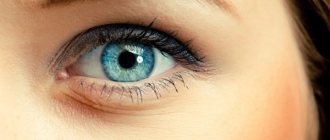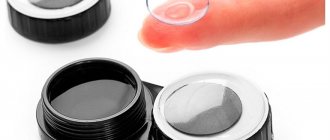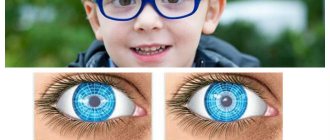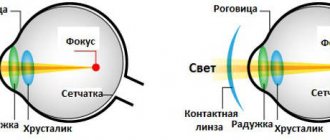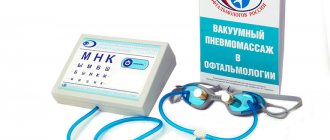More about the manifestations of the disease
Astigmatism is a deviation in which the cornea of the eye has an irregular shape. Because of this, light is not refracted as intended, resulting in distorted images. Another difficulty is that the distortion occurs not in one, but in several planes at once. In each plane, the cornea or lens has a different curvature. For this reason, special lenses are required to correct astigmatism.
Modern medicine classifies astigmatism into three degrees - the higher the degree, the more severe the disease:
· 1st degree. Visual deviation up to 3 diopters inclusive. Often a person does not even notice that his vision has deteriorated. However, he develops the habit of squinting to make his vision sharp.
· 2nd degree. Deviation from 3 to 6 diopters inclusive. A person with the second degree of astigmatism sees blurry, often double, images. The eyes get tired quickly, which causes headaches.
· 3rd degree. Deviation from 6 diopters. There is severe deformation of the cornea and serious defects in visible images. In especially severe cases, surgery is required for correction.
Both glasses and contact lenses are used to correct astigmatism. Their design depends on the degree of the disease. So, for first-degree correction, it is enough to use cylindrical and spherical glasses or lenses. The second and third degrees of astigmatism, as well as its mixed forms, are corrected with the help of toric contact lenses. Standard optical products simply will not bring the desired effect.
Tips for choosing
When selecting this type of optics, you need to take into account a number of parameters. These are:
- A person’s lifestyle, as well as his profession. It largely determines which lens format is more suitable, what material and mode of optics replacement should be preferred.
- General state of vision. This criterion is used to determine the optical power of the lenses and their type.
- Age characteristics. So, any type of lenses can be recommended for young people. But for elderly patients, samples are recommended that can be changed less frequently, since this process causes certain difficulties for this category of patients.
Toric optical products – what are their features?
Toric lenses are an excellent alternative to astigmatic glasses. They do not require a long time to get used to, and at the same time they are suitable for correcting severe forms of astigmatism, which no glasses, even with cylindrical lenses, can cope with. Toric optical products refract light along both meridians, since each of them has a positive or negative refractive power.
Externally, a toric lens looks like a ball compressed from two opposite sides. Depending on the result you want to achieve, either diverging or converging contact lenses are selected. Each such product contains two optical centers at once, which determines the effectiveness of the lenses.
Are regular lenses allowed for astigmatism?
People with astigmatism are not recommended to use ordinary contact lenses, that is, those products whose surface is spherical. Moreover, this is pointless - ordinary lenses are not capable of correcting vision. Although they eliminate the refractive effect in one plane, the similar effect in the second plane remains unchanged. This may cause discomfort that would not exist without lenses.
Another reason why you should not use standard contact lenses for astigmatism is that they are more likely to become misaligned. Products with a spherical surface shape rotate freely on the surface of the cornea, which is unacceptable for astigmatism. With every blink and turn of the head, conventional lenses move across the eye, disrupting their ability to focus light rays on the retina. This is one of the factors that can make vision worse.
Are colored lenses available to people with astigmatism?
Ophthalmologists do not prohibit people with astigmatism from using colored contact lenses. The main condition is that the surface of colored optical products must have a toric design. Only in this case will correct refractive correction be achieved in all planes. Naturally, you won’t be able to buy these lenses in any store. They will need to be selected individually with an ophthalmologist.
The range of colored contact lenses for people with astigmatism is not wide. In addition, they are significantly more expensive than clear lenses. The cost of color optical products is usually 20-30% higher than average.
Rules of care
To ensure that wearing lenses does not cause discomfort and ensures high visual acuity, it is necessary to select contact lenses individually, taking into account the existing eye parameters.
In addition to the required optical power, the radius of curvature of the lens surface (usually designated as BC), its thickness and water content in it (hydrophilicity), and the material of manufacture are important. The most commonly used are soft contact lenses made from special polymer materials (hydrogel or silicone hydrogel).
The most comfortable lenses to use are daily lenses, i.e. lenses whose wearing period does not exceed 7-10 hours. These lenses are the thinnest and have a high water content, but they are quite expensive.
There are certain indications for the prescription of rigid (gas-permeable) contact lenses (severe astigmatism, keratoconus). This type of contact lens has the highest oxygen throughput.
The selection of a specific type and type of contact lenses should only be carried out by a trained specialist after a detailed ophthalmological examination. When you first start using contact lenses, you may need moisturizing drops or drops that reduce corneal sensitivity to relieve eye adaptation symptoms.
You should be aware that colored contact lenses, especially long-wear ones, are not suitable for everyone, since the likelihood of allergies when using such lenses is greater than when wearing traditional contact lenses.
For people with dark eye color, most of the colored contact lenses offered today will not be suitable for a radical change in the color of the iris, because... they are essentially tint. Careful care of contact lenses determines not only their longevity, but also the maintenance of eye health.
Modern types of contact lenses, as mentioned above, are easy to use, both in terms of use and care. You should not worry about the difficulty of caring for contact lenses; modern disinfectants can reduce these efforts to a minimum.
Most contact lens solutions are multi-purpose, i.e. perform simultaneously the functions of moisturizing, cleaning, disinfecting, and is suitable for storing lenses. For those who are intimidated by the need to care for their contact lenses every day, daily disposable soft contact lenses are the best choice.
To prevent small problems from leading to big troubles, if you experience the slightest symptoms of discomfort while wearing contact lenses, you should temporarily stop using them and immediately see a doctor.
Since some complications when wearing contact lenses may initially occur without any symptoms, you should not ignore follow-up examinations with an ophthalmologist (at least 1-2 times a year).
How to put on contact lenses?
To put it on correctly, follow these steps:
- Wash your hands thoroughly and dry them with a lint-free towel.
- Use special plastic tweezers to remove the lens from the container.
- Place the correction device on the index finger so that its edges are directed upward.
- Pull your eyelids back with the fingers of your other hand.
- Look exclusively straight or up.
- Carefully place the lens on the cornea.
- Blink so that she takes the required position
How to choose the right lenses?
The choice of contact lenses for the correction of astigmatism must definitely be made together with an ophthalmologist. This is true for any optical products. The type of stabilization that ensures the correct position of the lens on the eye has a great influence on the choice of product. There are three types in total:
· Ballast. In this case, the design of the lens involves a point where a heavy seal is present. This ballast, due to its weight, pulls the lens down and fixes it in the desired position. This stabilization option is bad because it is not able to maintain the position of the lens when the head is tilted too much.
· Periballast. The most effective stabilization option. The lenses are designed in such a way that their upper and lower edges are fixed by the natural pressure of the eyelids. The fixation in this case is so strong that the lenses maintain the desired position even when a person plays sports.
· Cutting off the edge of the lens. This stabilization system allows the contact lens to remain in place under the natural pressure of the lower eyelid. The disadvantage of this method is that there is a high risk of lens displacement during intense blinking. This impairs vision correction.
It is easy to understand that the preferred contact lenses are those in which the periballast is responsible for stabilization. You will have to pay more for these products, but they are much more comfortable to use.
Which contact lenses are worth considering?
Today on sale you can find a range of contact lenses designed to correct astigmatism. Such products are made using biocompatible materials, which ensures wearing comfort. It is most convenient for people with astigmatism to use daily lenses of the following brands:
- · DAILIES AquaComfort Plus. Contact lenses with toric coating. Well compatible with both ocular tissues and natural human tears. This is an excellent choice for people with allergies.
- · AirOptix for Astigmatism. Lenses based on fluorine silicone hydrogel material. They contain a large amount of moisture and are highly breathable. Good for those who suffer from dry eyes.
- · PureVision 2 HD for Astigmatism. Lenses of this brand are optimal for people who engage in sports or active physical activity. Products are manufactured using Auto-Align Design technology.
- · Clariti1-day toric. Lenses with a high level of moisture. Good for users with dry eyes. Does not cause discomfort throughout the day. Made from silicone hydrogel.
- · 1-Day Acuvue Moist for Astigmatism. These contact lenses were developed using four-zone stabilization and blink hydration technology. A universal brand for any situation. Available in packs of 30 and 90 pieces.
- · Acuvue Oasys 1-Day with HydraLuxe for Astigmatism. This is an improved version of the previous brand. The main addition is an enhanced degree of protection of the visual organs from the effects of harmful ultraviolet radiation, moisturizing the cornea and a high level of comfort.
- · Acuvue Oasys for Astigmatism with Hydraclear Plus. The advantage of these lenses is that they can be worn for 7 days in a row, including during sleep. There will be no discomfort.
- Biofinity Toric. A silicone hydrogel contact lens with a monthly replacement schedule that has a high level of oxygen permeability and protects the cornea from drying out.
Do you suffer from astigmatism and are looking for contact lenses to correct your vision?
We invite you to browse the online store catalog, select suitable products and buy them at an affordable price with fast delivery! « to the article section
Soft and hard
Previously, only hard eyepieces were used to correct astigmatism, which often provoked the development of hypoxia. Modern models differ significantly from their predecessors. They have high throughput and allow oxygen to freely penetrate to the eyes. Due to their cruelty, the products fit tightly to the surface of the organ of vision, therefore they are better able to eliminate astigmatism.
However, such eyepieces also have some disadvantages:
- Long adaptation period;
- Patients may experience individual intolerance to optics;
- When foreign particles penetrate under the “plate,” a person experiences pain and stinging.
You can find hard lenses for night wear on the market. They act in a special way. They are put on before going to bed; during the night's rest, the surface of the cornea is smoothed out and takes on the correct shape. The achieved effect lasts throughout the day. Such a correction requires mandatory consultation with a doctor. The products have a high price tag, however, they can be used for two years without replacement.
Soft lenses preserve the ability of the visual apparatus to maintain a humid environment. They are 100% breathable, the “plate” fits tightly to the cornea and completely follows its shape. Thanks to such characteristics, the adaptation period passes unnoticed.
Among the disadvantages of eyepieces, it is worth noting the fact that with their help it is impossible to increase visual acuity. The lack of the required rigidity does not allow obtaining maximum image clarity. Also, soft optics often cause the eyeball to dry out, so it is necessary to regularly use moisturizing drops.


